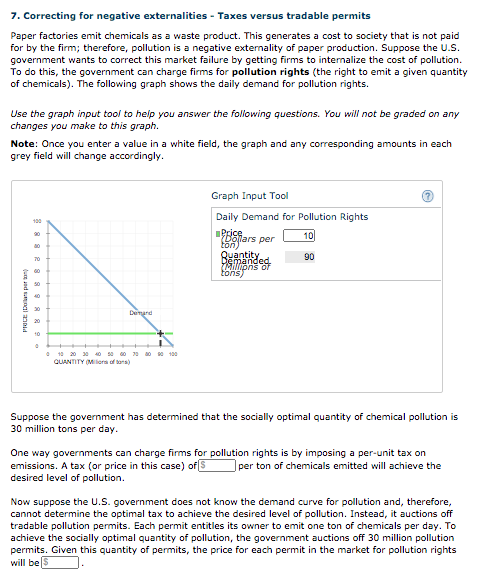Suppose the government has determined that the socially optimal quantity of chemical pollution is 30 million tons per day. One way governments can charge firms for pollution rights is by imposing a per-unit tax on emissions. A tax (or price in this case) of[S desired level of pollution. per ton of chemicals emitted will achieve the Now suppose the U.S. government does not know the demand curve for pollution and, therefore, cannot determine the optimal tax to achieve the desired level of pollution. Instead, it auctions off tradable pollution permits. Each permit entitles its owner to emit one ton of chemicals per day. To achieve the socially optimal quantity of pollution, the government auctions off 30 million pollution permits. Given this quantity of permits, the price for each permit in the market for pollution rights will bes
Suppose the government has determined that the socially optimal quantity of chemical pollution is 30 million tons per day. One way governments can charge firms for pollution rights is by imposing a per-unit tax on emissions. A tax (or price in this case) of[S desired level of pollution. per ton of chemicals emitted will achieve the Now suppose the U.S. government does not know the demand curve for pollution and, therefore, cannot determine the optimal tax to achieve the desired level of pollution. Instead, it auctions off tradable pollution permits. Each permit entitles its owner to emit one ton of chemicals per day. To achieve the socially optimal quantity of pollution, the government auctions off 30 million pollution permits. Given this quantity of permits, the price for each permit in the market for pollution rights will bes
Chapter19: Externalities And Public Goods
Section: Chapter Questions
Problem 19.6P
Related questions
Question

Transcribed Image Text:Suppose the government has determined that the socially optimal quantity of chemical pollution is
30 million tons per day.
One way governments can charge firms for pollution rights is by imposing a per-unit tax on
emissions. A tax (or price in this case) of[S
desired level of pollution.
per ton of chemicals emitted will achieve the
Now suppose the U.S. government does not know the demand curve for pollution and, therefore,
cannot determine the optimal tax to achieve the desired level of pollution. Instead, it auctions off
tradable pollution permits. Each permit entitles its owner to emit one ton of chemicals per day. To
achieve the socially optimal quantity of pollution, the government auctions off 30 million pollution
permits. Given this quantity of permits, the price for each permit in the market for pollution rights
will bes

Expert Solution
This question has been solved!
Explore an expertly crafted, step-by-step solution for a thorough understanding of key concepts.
This is a popular solution!
Trending now
This is a popular solution!
Step by step
Solved in 2 steps with 1 images

Knowledge Booster
Learn more about
Need a deep-dive on the concept behind this application? Look no further. Learn more about this topic, economics and related others by exploring similar questions and additional content below.Recommended textbooks for you


Exploring Economics
Economics
ISBN:
9781544336329
Author:
Robert L. Sexton
Publisher:
SAGE Publications, Inc

Principles of Economics 2e
Economics
ISBN:
9781947172364
Author:
Steven A. Greenlaw; David Shapiro
Publisher:
OpenStax


Exploring Economics
Economics
ISBN:
9781544336329
Author:
Robert L. Sexton
Publisher:
SAGE Publications, Inc

Principles of Economics 2e
Economics
ISBN:
9781947172364
Author:
Steven A. Greenlaw; David Shapiro
Publisher:
OpenStax


